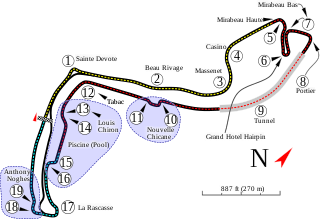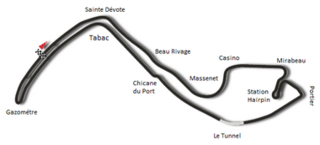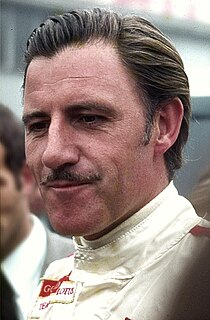Related Research Articles

The Monaco Grand Prix is a Formula One motor racing event held annually on the Circuit de Monaco, in late May or early June. Run since 1929, it is widely considered to be one of the most important and prestigious automobile races in the world, and is one of the races—along with the Indianapolis 500 and the 24 Hours of Le Mans—that form the Triple Crown of Motorsport. The circuit has been called "an exceptional location of glamour and prestige". The Formula One event is usually held on the last weekend of May and is known as one of the largest weekends in auto racing, as the Formula One race occurs on the same Sunday as the Indianapolis 500 and the Coca-Cola 600.

Damon Graham Devereux Hill, is a British former professional racing driver from England and the 1996 Formula One World Champion. He is the son of Graham Hill, and, along with Nico Rosberg, one of two sons of a Formula One World Champion to also win the title. He started racing on motorbikes in 1981, and after minor success moved on to single-seater racing cars.

Norman Graham Hill was a British racing driver and team owner, who was the Formula One World Champion twice, winning in 1962 and 1968 as well as being runner up on three occasions. Despite not passing his driving test until 1953 when he was already 24 years of age, and only entering the world of motorsports a year later, Hill would go on to become one of the greatest drivers of his generation. Hill is most celebrated for being the only driver ever to win the Triple Crown of Motorsport, an achievement which he defined as winning the Indianapolis 500, the 24 Hours of Le Mans, and the Formula One World Drivers' Championship. While several of his peers have also espoused this definition, including fellow F1 World Champion Jacques Villeneuve, the achievement is today most commonly defined as including the Monaco Grand Prix rather than the Formula One World Championship. By this newer definition, Hill is still the only driver to have ever won the Triple Crown, winning at Monaco with such frequency in the 1960s that he became known as "Mr. Monaco". Hill crashed at the 1969 United States Grand Prix and was seriously injured, breaking both his legs and ending his season. Although he would recover and continue to race until 1975, Hill's career would never again reach the same heights, and the Monaco Grand Prix victory earlier in 1969 would be his last victory in Formula One.

James Simon Wallis Hunt was a British racing driver who won the Formula One World Championship in 1976. After retiring from racing in 1979, Hunt became a media commentator and businessman.

William Charles Frederick Grover-Williams, also known as "W Williams", was a British Grand Prix motor racing driver and special agent who worked for the Special Operations Executive (SOE) inside France. As a racing driver, he is best known for winning the first Monaco Grand Prix and as an SOE agent he organised and coordinated the Chestnut network, before being captured and executed by the Nazis.

Circuit de Monaco is a 3.337 km (2.074 mi) street circuit laid out on the city streets of Monte Carlo and La Condamine around the harbour of the Principality of Monaco. It is commonly, and even officially, referred to as "Monte Carlo" because it is largely inside the Monte Carlo neighbourhood of Monaco.

Louis Alexandre Chiron was a Monégasque racing driver who competed in rallies, sports car races, and Grands Prix.

The Porsche 804 is a single-seat, open-wheeled racing car produced by Porsche to compete in Formula One (F1). It raced for a single season in 1962 in the 1½ litre formula.

The 1961 Monaco Grand Prix was a Formula One motor race held on 14 May 1961 on the Circuit de Monaco in Monte Carlo, Monaco. It was race 1 of 8 in both the 1961 World Championship of Drivers and the 1961 International Cup for Formula One Manufacturers. It was also the first World Championship race under the new 1.5 litre engine regulations.

The 1966 Monaco Grand Prix was a Formula One motor race held at the Circuit de Monaco on 22 May 1966. It was race 1 of 9 in both the 1966 World Championship of Drivers and the 1966 International Cup for Formula One Manufacturers. The race was the first World Championship event of a new era for Formula One, for which engine regulations were altered from 1.5 litres of maximum engine displacement to 3.0 litres. The race was the 24th Monaco Grand Prix.

The 1967 Monaco Grand Prix was a Formula One motor race held at Monaco on May 7, 1967. It was race 2 of 11 in both the 1967 World Championship of Drivers and the 1967 International Cup for Formula One Manufacturers, albeit four months after Pedro Rodríguez's unexpected victory at Kyalami. The 100-lap race was won by Brabham driver Denny Hulme after he started from fourth position. Graham Hill finished second for the Lotus team and Ferrari driver Chris Amon came in third.

The 1968 Monaco Grand Prix was a Formula One motor race held at the Monte Carlo Circuit on 26 May 1968. It was race 3 of 12 in both the 1968 World Championship of Drivers and the 1968 International Cup for Formula One Manufacturers. The race was won by Lotus driver Graham Hill, who started from pole position. Richard Attwood, driving for BRM, gained second place and fastest lap, while Lucien Bianchi finished in third position in a Cooper, in what was to be these two drivers' only podium finishes.

The 1970 South African Grand Prix, formally titled the Fourth AA Grand Prix of South Africa, was a Formula One motor race held at Kyalami Circuit on 7 March 1970. It was race 1 of 13 in both the 1970 World Championship of Drivers and the 1970 International Cup for Formula One Manufacturers. It was also the 14th and last Formula One victory for triple world champion Jack Brabham.

The 1993 Monaco Grand Prix was a Formula One motor race held at Monaco on 23 May 1993. It was the sixth race of the 1993 Formula One World Championship.
Anthony William Brise was an English racing driver, who took part in ten Formula One Grand Prix events in 1975, before dying in a plane crash with Graham Hill.
Embassy Racing With Graham Hill, commonly abbreviated to Embassy Hill, was a short-lived Formula One team started by two-time Formula One World Champion Graham Hill. The team debuted in 1973 with a customer Shadow DN1 car, and began racing as a constructor with its own chassis in 1975. The team had limited success in three seasons of racing, but everything was cut short by the death of Hill, Tony Brise and some of the team's top personnel in the crash of a light aircraft in the autumn before the 1976 season. The team was sponsored by Imperial Tobacco's Embassy cigarette brand and ran under various names during its time.

The Lotus 49 was a Formula One racing car designed by Colin Chapman and Maurice Philippe for the 1967 F1 season. It was designed around the Cosworth DFV engine that would power most of the Formula One grid through the 1970s. It was one of the first F1 cars to use a stressed-member drivetrain to reduce weight, and the first to be widely copied by other teams.

The Triple Crown of Motorsport is an unofficial motorsport achievement, often regarded as winning three of the most prestigious motor races in the world in one's career:

The BRM P261, also known as the BRM P61 Mark II, is a Formula One motor racing car, designed and built by the British Racing Motors team in Bourne, Lincolnshire, England. The BRM P261 was introduced for the 1964 Formula One season, and its design was an evolution of Tony Rudd's one-off BRM P61 car of 1963. The P261 had a relatively long racing career; variants of the car were still being entered for Formula One World Championship Grands Prix as late as 1968. During the course of their front-line career BRM P261s won six World Championship races, in the hands of works drivers Graham Hill and Jackie Stewart, and finished second in both the Drivers' and Constructors' Championship standings in 1964 and 1965. Stewart, Hill and Richard Attwood also used works P261s to compete in the Tasman Series in 1966. The BRMs dominated, with Stewart winning four, Hill two, and Attwood one of the 1966 Tasman Series' eight races. Stewart also won the title. The works-backed Reg Parnell Racing team returned in 1967 with Stewart and Attwood, where Stewart added another two wins to his tally. In terms of races won and total Championship points scored, the P261 was the most successful car in BRM's history.
References
- 1 2 Eric Jackson (11 November 2012). Petrol In My Blood. Lulu.com. p. 99. ISBN 978-1-105-33484-9.
- 1 2 3 Opus Media (10 January 2014). The Official Formula1 Opus eBook: The Whole Story. BookBaby. ISBN 978-1-905794-94-2.
- ↑ Graham Hill; Neil Ewart (1976). Graham. Hutchinson. p. 123. ISBN 978-0-09-127930-1.
- ↑ Malcolm Folley (18 May 2017). Monaco: Inside F1’s Greatest Race. Random House. p. 420. ISBN 978-1-4735-3773-6.
- ↑ Lighthouse: Journal of the Canadian Hydrographers' Association. The Association. 1994. p. 47.
- 1 2 Michael Kempley (18 February 2006). "See you at Rosie's". The Daily Telegraph . Retrieved 22 February 2019.
- ↑ Jill Treanor; Jon Henley (4 December 1999). "No more the easy life, but a life cheaply taken". The Guardian . Retrieved 22 February 2019.
- ↑ The Hydrographic Journal. Hydrographic Society. 1997.
- ↑ Rosie Bernard; Lorie Coffey (2007). Rosie's Memories: The Story of Rosie Bernard and Her Memories of Monaco and the Chatham Bar. Red Mist Books. ISBN 978-0-9556622-0-1.